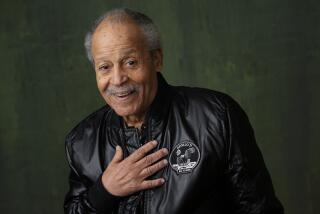Hero or hoax? Public doubted pilot’s story of survival
- Share via
On May 9, 1957, Air Force Lt. David Steeves, piloting a T-33 training jet, took off from Hamilton Air Force Base, near San Francisco, on a flight to Arizona. Then, like a character in the television show the “Twilight Zone,” he disappeared.
Days passed, then weeks. When no trace of Steeves or the plane was found, the Air Force declared the 23-year-old pilot officially dead.
But, 54 days after he vanished, a gaunt, bearded Steeves, filthy clothing hanging from his body, hobbled into a camp in the remote backcountry of Kings Canyon National Park, east of Fresno. He told an almost unbelievable tale of survival.
“Something in the plane exploded” and he blacked out, he said. When he regained consciousness, he ejected from the out-of-control jet, badly injuring both ankles when he landed.
Without food or shelter for 15 days, he survived freezing temperatures at 12,000 feet while “crawling, slipping and sliding to safety over 20 torturous miles of high country considered impassable even now to trained mountaineers,” The Times reported.
“All I had to keep warm with was my parachute, so I wrapped up in it,” Steeves said.
Eventually, he found an abandoned National Park Service cabin and broke in. He found a few cans of food as well as a fisherman’s fly kit. He caught fish and trapped and killed a deer at a salt lick using his .32-caliber pistol and a piece of string, he said.
After regaining some of his strength, he tried to cross the rain-swollen Kings River but nearly drowned and lost some of the clothes he had tied around his neck.
Luckily, he stumbled upon a pack-train guide who took him by horse to civilization.
“My ankles are still swollen — otherwise I guess I’m okay,” the pilot told reporters a couple of days later after being flown to Lockheed Air Terminal (now Bob Hope Airport) in Burbank. The Air Force found him lodging that night at the Knickerbocker Hotel in Hollywood, a stopover en route to a reunion with his wife, Rita, at their home in Trumbull, Conn.
Steeves became a media sensation of sorts.
He appeared as a guest on several television shows, including Art Linkletter’s “House Party.”
“There was talk of a movie,” said San Diego-area author Eric Blehm, who is writing a book about Steeves. “His life rights were optioned.”
Steeves “liked the whole Hollywood persona,” said Blehm. “He was handsome, smoked pipes and cigars, drove a beautiful Corvette and he was a happy-go-lucky jet pilot — the ‘Top Gun’ Tom Cruise of his era.”
But the fact that the plane hadn’t been found left doubts in some minds.
A writer from the Saturday Evening Post accompanied Steeves to the Sierra Nevada later that summer, but the snow had melted and the pilot had trouble finding his trail.
The Post canceled a deal for a magazine series, citing inconsistencies in Steeves’ story. Henry Holt & Co. canceled a book deal.
No movie was ever made.
The Air Force announced a “thorough but routine” investigation of Steeves’ disappearance.
Some called his account a hoax — or worse.
This was the height of the Cold War, when Americans were worried about the Soviet Union. Could Steeves have flown his jet to Mexico? Could he have somehow sold the technology to the Russians?
But what doubters didn’t realize was “how these mountains have the amazing ability to hide things,” said Blehm, a backpacker for a quarter of a century. “They are so rugged that you could be standing 5 feet away from something and not even see it.”
The doubters also ignored the discovery of Steeves’ parachute and evidence that he had studied parks records in the cabin to orient himself.
The pilot, however, did not ease doubts when he testily noted: “People can believe or disbelieve it as they choose. If the story is so miraculous they don’t believe it, then it is just that much better of a story.”
His marriage fell apart and he resigned from the Air Force.
He returned to Los Angeles at one point, not as a celebrity but as a plaintiff against the Post and Henry Holt, claiming breach of contract. The suits were settled out of court.
Steeves moved to Fresno, west of where he ejected. In the following years, he flew over the Sierra again and again on his own, looking for any sign of the wreckage.
But on Oct. 16, 1965, he was killed when a private plane he was piloting crashed in Boise, Idaho.
Steeves’ story faded into obscurity until 1978 when rangers in Kings Canyon reported that Boy Scouts visiting from Los Angeles had found wreckage in the area where the pilot had ejected — the canopy of a T-33. It bore the serial number (52-92-32) of Steeves’ canopy. It was the vindication Steeves had sought for so long.
The rest of the aircraft was never found. One ranger theorized that it “could have gone out over the ocean” and crashed after Steeves bailed out.
More to Read
Sign up for Essential California
The most important California stories and recommendations in your inbox every morning.
You may occasionally receive promotional content from the Los Angeles Times.










